Inlandsbanan is a rail line through central and northern Sweden. While parts of the railway are open for regular traffic year round, there are daily tourist trains during summer.
Much of the line is parallel to the E45 road.
Understand

Completed in 1937, Inlandsbanan was the last major railway to be built in Sweden until the 1990s, and it remains the only major railway without electrification.
The railway was envisioned in the late 19th century and the parliament decision was taken 1907. The railway was then built, leg by leg, but the last part was delayed and was not completed until 1937. The intent was both to have an inland railway for military reasons (easier to defend than the main one close to the coast) and to stimulate the economy of the remote northern inland.
By the time the railway was completed the golden age of railways was gone, the distances too long and the technical standard of the railway too low to fulfil the intentions. Increased car ownership reduced the passenger volumes and finally in the 1990s SJ was about to shut it down. The municipalities along the railway, however, founded the Inlandsbanan AB company in 1993, bought the railway and took over traffic.
Prepare
- Destination Inlandsbanan AB, Storsjöstråket 19, 831 27 Östersund, ☏ +46 771-535353, boka@inlandsbanan.se. M-F 09:00-12:00, 13:00-16:00. Tickets and information.
Sample prices (2019):
- Kristinehamn – Mora 340 kr
- Mora – Östersund 596 kr
- Östersund – Sorsele 760 kr
- Östersund – Gällivare 1 378 kr
Get in
The termini and transfer points are railway junctions and they are accessible by train from elsewhere, if you want to start your trip elsewhere they might be accessible by bus. You could get in by car, but then you need to backtrack or have someone else bringing away the car. Finally some of the places along the itinerary are served by air.
Go

During the summer months there is passenger traffic along the entirety of the line. As of 2017 this journey is made up of three sections, and tickets are sold by the company Inlandsbanan. The southernmost section from Kristinehamn to Mora is operated by Tågab, with trains starting in Kristinehamn in the morning, turning around in Mora in the afternoon where it meets the train from (the middle section) Östersund that has likewise started in the morning allowing passengers travelling north to south or vice versa to switch trains. The trains will then get back to Kristinehamn and Östersund each arriving there in the evening. You have to stay the night in Östersund, regardless of which direction you travel. The northernmost section then takes a full day with trains starting in Östersund and Gällivare in the morning and arriving at the other end in the evening. Thus the journey of a grand total of 1,363 km (847 mi) will take at least two days. Timetable
Termini and transfer points are boldened.
- Kristinehamn
- Nässundet
- Storfors
- Nykroppa
- Grythyttan
- Hällefors
- Ställdalen
- Grängesberg
- Ludvika

Ämån in Orsa. The construct to the left is for log driving, for which the river was important. The railway bridge in the background. - Borlänge C
- Leksand
- Rättvik
- Mora Station
- Vattnäs
- Orsa
- Tallhed
- Älvho
- Lillhamra
- Tandsjöborg
- Fågelsjö
- Bäckedal
- Sveg
- Ytterhogdal
- Överhogdal Hbdg
- Sörtjärn
- Nederhögen

Stop on request: Fågelsjö station - Röjan
- Kvarnsjö
- Åsarna
- Svenstavik C
- Hackås
- Fåker
- Tandsbyn
- Brunflo
- Östersund C
- Östersund V
- Jamtli
- Lit
- Häggenås
- Munkflohögen
- Jämtlands Sikås
Train interior - Hallviken
- Ulriksfors
- Lövberga
- Hoting Camping
- Hoting
- Dorotea Camping
- Dorotea
- Meselefors Camping
- Meselefors
- Vilhelmina
- Vilhelmina Norra
- Vojmån
- Storuman
- Sandsjönäs
- Blattnicksele
- Sorsele
- Buresjön
- Slagnäs
- Renviken
- Avaviken
- Arvidsjaur

Bridge over Pite älv. Mind oncoming traffic! - Moskosel
- Varjisträsk
- Kåbdalis
- Geografiska Polcirkeln (Polar Circle)
- Jokkmokk
- Vaikijaur
- Porjus
- Gällivare
See
- The line gives great opportunities to spot Eurasian wildlife. It goes through Laponia near Porjus, giving some spectacular views of the national park system.
- Moskosel has a navvy (railway construction) museum. Some of the bridges along the railway are interesting showcases of engineering a century ago.
Eat and drink
There is coffee and snacks served on the train.
In summer the train stops for meals at suitable stations. Order in time, so that the food is ready on arrival. On some stations the meals are takeaway, to be eaten outdoors or on the train. Check the timetable.
The food is mostly made on-site, often influenced by local traditions.
Connect
Wi-Fi and USB outlets onboard.
Stay safe
Trains running along this line do occasionally collide with wildlife, particularly moose (Alces alces).
Go next
The railway goes through Stubba Nature Reserve in Laponia. You could get off in Porjus to visit Muddus National Park, or Stubba or Sjaunja Nature Reserves, or in Jokkmokk to continue by bus to Kvikkjokk by Padjelanta National Park and hike along Padjelantaleden, Kungsleden or Nordkalottleden. From Gällivare Dundret Nature Reserve is close by.




